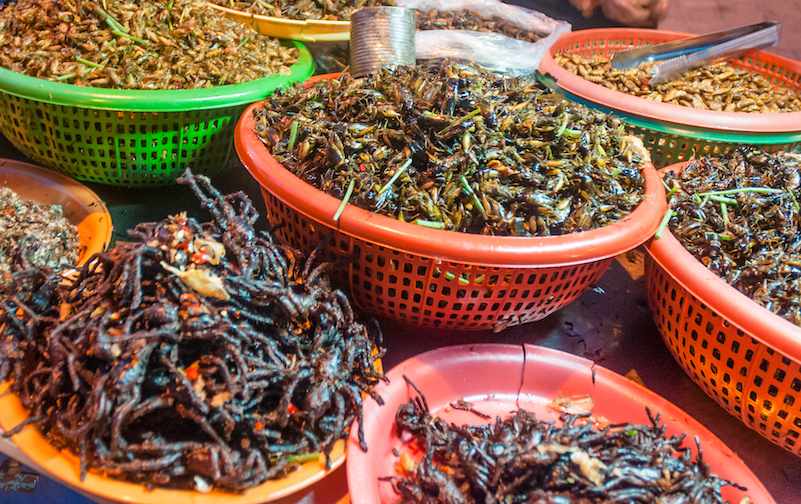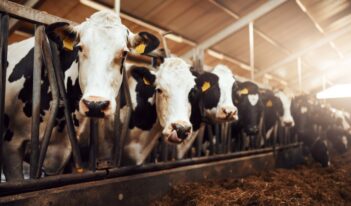
Edible insects may become essential in the wake of the COVID-19 crisis, but FDA regulation is lacking.
As COVID-19 rages on and the threat of a global food crisis looms large, the European Food Safety Authority of the European Union (EU) is expected to authorize the sale of insects for human consumption soon. Such a decision would likely invite a renewed look at the future of edible insect regulation in the United States, given that the pandemic’s threat to the global food supply could also cause a national meat shortage.
The recent closures of major meat packing plants as a result of COVID-19 has restricted U.S. meat production while consumer demand is on the rise. In particular, the U.S. Department of Agriculture announced that between March and April, frozen pork in storage declined 4 percent and slaughter rates dropped 25 percent.
Although many news sources have commented that it is still too early to declare a food crisis, others have warned that U.S. food banks may have to begin rationing. Some economists predict that consumers will notice significantly fewer options for meat and protein beginning this month.
Because the coronavirus pandemic has directly impacted the agriculture sector and other sectors tied to food production, members of the edible insects industry have praised the promise of the European Union’s long-awaited authorization of the sale of certain edible insects, hoping that the EU’s expected ruling will “have a snowball effect.”
An EU authorization could create such a snowball effect in the United States. Insects’ high quantity of protein, vitamins, and minerals—which rivals that of fish and meat—could fill the gap left by U.S. meat producers during the COVID-19 crisis.
In the United States, however, federal regulation of insects for human consumption has largely been characterized by regulatory inaction. Edible insects fall within the oversight of the U.S. Food and Drug Administration (FDA). Most of FDA’s attention, however, has not been focused on regulating insects as human food, but rather on regulating insects as “filth.” The agency has traditionally prohibited insect parts in food, treating them as adulterants under the Federal Food, Drug, and Cosmetic Act (FDCA). In fact, a recent review of available, relevant, and official FDA documents found that the term “insect” had only been used in relation to adulteration with defects.
The reasoning underlying this historical treatment of insects only as “filth” stems from primarily cultural norms surrounding food. The “filth” designation is also based on a presumption that the presence of insects in a food facility, as well as the unintentional presence of insects in human food, suggests unsanitary conditions and probable contamination, which some courts have held renders a food adulterated under the FDCA.
As the edible insect industry in the United States has grown in recent years, legal scholars have theorized about how FDA could regulate insects as human food or food ingredients within the agency’s existing framework. One of the more popular analyses for edible insect regulation argues that insects used as food or as a component of food are in fact “food” under the FDCA’s broad definition of the term: “articles used for food or drink for man” or “articles used for components of any such article.”
Under this regulatory framework, insect food products and insect-based food products would be subject to all relevant sections of the FDCA and must be processed using current good manufacturing practices. Insect-specific processing standards are particularly important to ensure edible insects’ safety, as one recent study reported that the biological and chemical hazards of using farmed insects for human consumption depend on how the insects are reared and processed.
FDA has typically responded to edible insect inquiries by stating that insects are considered food if they are to be used for food or as components of food. This response has been viewed by some observers as an informal acceptance of the use of insects in or as human food. But such a response is far from binding on the agency or regulated industries—it does not even constitute official guidance. Even with FDA’s informal and ambiguous tolerance of insects as food, regulatory pitfalls remain.
For example, one legal commentator has noted that FDA’s standard response lacks clear guidance for insects used as a “food additive” under the FDCA. “Food additives” must either be determined to be generally recognized as safe or else go through a safety evaluation for their intended use. Regulating insects using the FDCA’s “food additive” provisions “ultimately would likely be unworkable due to the serious limitations” of the food additive approval process. For instance, given the millions of insect species in the world, the fact that each new species would require a separate FDA approval for use would potentially overwhelm the agency’s capacity.
Legal scholars have also recently suggested that there could be additional labeling requirements for insects as food based on an internal FDA memorandum from 1995 which stated that lollipops that intentionally contained insects are “novel, and therefore unexpected,” requiring a greater than usual burden on labeling.
The greatest barrier to effective regulation of insects for human food appears to be FDA’s silence on insects as anything but food defects. The agency has received inquiries about insects for use as human food for decades but still has made little progress in regulating this food source. Particularly in this global health crisis that threatens the global food supply—and, more close-to-home, the U.S. meat supply—edible insects’ potential might appear to demand regulatory action with greater urgency.
Most pressingly, legal commentators argue, FDA ought to be explicit in treating insects used as food as “food” under the FDCA. The agency, they say, must “provide a principled way to distinguish between insects as ‘filth’ and insects as ‘food.’”



